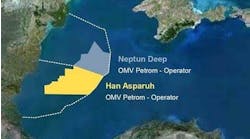Deepwater discoveries
David Paganie • Houston
Newfield Exploration Co. and Anadarko have recently announced discoveries in the deepwater Gulf of Mexico. Newfield made two discoveries - Pyrenees and Winter. Pyrenees, in 2,100 ft (640 m) of water in Garden Banks block 293, encountered 125 ft (38 m) of net hydrocarbon pay in three separate intervals. Development planning is under way, with a delineation well scheduled for the second half of this year.
Newfield operates Pyrenees with a 40% working interest. Partners are Stone Energy Corp. (15%), Ridgewood Energy Corp. (15%), Arena Exploration (15%), and Deep Gulf Energy (15%).
The Winter discovery, in 3,400 ft (1,036 m) of water in Garden Banks block 605, encountered 44 ft (13 m) of net hydrocarbon pay in two sands. Various development options are being considered. Newfield operates Winter with a 30% working interest. Partners are Apache Corp. (25%), Deep Gulf Energy (25%), and Royal Offshore (20%).
Anadarko made a discovery on the Samurai prospect in Green Canyon block 432. The discovery well, in 3,400 ft (1,036 m) of water, encountered more than 120 ft (37 m) of net oil pay in several high-quality sands. An appraisal well is planned within the next year. Anadarko operates the block with a 33.33% working interest. Partners include Murphy Oil and Samson Offshore, each with a 33.33% working interest.
In other deepwater news, Mariner has started production from the Geauxpher field in Garden Banks block 72. In less than 12 months from discovery, the field was flowing approximately 115 MMcfe/d of natural gas gross. Mariner-operated Geauxpher, in 2,700 (823 m) of water, is a two-well, 40-mi (64-km) tieback to Garden Banks block 72. Its reserves potential is estimated at more than 100 bcfe gross.
Mariner plans to start up two additional deepwater fields in this year – Daniel Boone, a one-well, 22-mi (35-km) tieback from Green Canyon block 646 in 4,250 ft (1,295 m) of water; and a one-well, three-mi (5-km) tieback from Viosca Knoll block 821 in 1,000 ft (305 m) of water.
Forecasters predict normal hurricane season
Renowned hurricane forecasters from NOAA and Colorado State University agree that activity in the 2009 Atlantic hurricane season is likely to be near-normal.
NOAA forecasters say a near-normal Atlantic hurricane season is most likely this year, while CSU predicts below-average activity.
In its initial outlook for the 2009 Atlantic hurricane season, which runs from June through November, NOAA’s National Weather Service Climate Prediction Center calls for a 50% probability of a near-normal season, a 25% probability of an above-normal season, and a 25% probability of a below-normal season. NOAA forecasters say there is a 70% chance of having nine to 14 named storms, of which four to seven could become hurricanes, including one to three major hurricanes (Category 3, 4, or 5). According to NOAA, an average season has 11 named storms, six hurricanes, and two major hurricanes.
CSU predicts that 2009 will have about five hurricanes, 11 named storms, 50 named storm days, 20 hurricane days, two major (Category 3, 4, or 5) hurricanes, and four major hurricane days. According to CSU, an average season has five hurricanes, 9.6 named storms, 49.1 storm days, 24.5 hurricane days, 2.3 major hurricanes, and five major hurricane days.
Tropical systems acquire a name, the first for 2009 will be Ana, upon reaching tropical storm strength with sustained winds of at least 39 mph. Tropical storms become hurricanes when winds reach 74 mph, and become major hurricanes when winds increase to 111 mph.
Supporting more activity this season, NOAA says, are conditions associated with the ongoing high-activity era that began in 1995, which include enhanced rainfall over West Africa, warmer Atlantic waters, and reduced wind shear. But activity could be reduced if El Niño develops in the equatorial Eastern Pacific this summer or if ocean temperatures in the eastern tropical Atlantic remain cooler than normal, says NOAA.
CSU expects neutral ENSO conditions to persist or perhaps transition to weak El Niño by the most active portion of the hurricane season (August-October). If El Niño conditions develop, it would tend to increase the levels of vertical wind shear and decrease the levels of Atlantic hurricane activity, CSU says.
Both NOAA and CSU will issue an updated hurricane outlook in early August.
Helix installs subsea equipment on Thunder Hawk
Helix Energy Solutions has installed two 86-ton (78-metric-ton) pipeline-end-termination (PLET) modules on the Thunder Hawk field in the Gulf of Mexico.
A total of four PLETs were installed, including two 8-in. (20-cm) infill flowline units, and two 12-in. (30-cm) modules for tie-back into the Mardi Gras export lines. The individual mud-matted PLETs measured 40 ft x 40 ft (12 x 12 m) with 20-in. (51-cm) connectors for the gas export line and 16-in. (41-cm) connectors to the oil line. With the connected 12-in. (30-cm) pipeline, the PLETs weighed up to 200 tons (181 metric tons) each. Helix is in the preparation phase of installing 16-in. and 20-in. export jumpers associated with the PLETs. Spitzer Industries fabricated the PLETs at its Green Bayou facility near Houston.
First production from Murphy-operated Thunder Hawk is expected in the second half of this year via a stand-alone semisubmersible production unit with capacity expandable to 60,000 b/d of oil. Thunder Hawk is in Mississippi Canyon block 736.
New contracts
ATP Oil & Gas has awarded 2H Offshore a contract to verify the design, fabrication, and installation of a flexible production riser for the Telemark development in Atwater Valley block 63. The high-pressure (12,500 psi) oil flexible catenary riser will tieback to ATP’sTitan MinDoc floating platform in 1,357 m (4,450 ft) of water.
Also for Telemark, Bluewater Industries has awarded Weatherford International a contract to supply a subsea production control system. The subsea portion of the system is comprised of a control module, base, and tree instrumentation.
Petrobras America has awarded SPT Energy Group (SPT) a contract for the inspection services associated with the offshore installation of the Cascade/Chinook pipeline. The inspection services include welding, coating, and AUT inspectors for the onshore fabrication and offshore installation for both reel-lay and J-lay vessels. The work began in April and is scheduled for completion in mid-2010.




